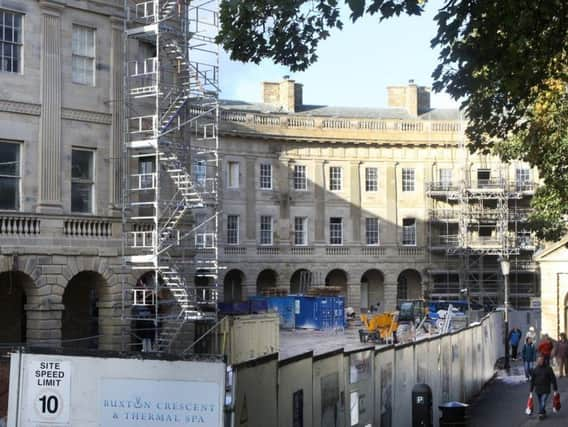Buxton Crescent: Derbyshire County Council approves extra £5.7m for 'vital' hotel and spa development


Last week, Derbyshire County Council revealed that the price of costly conservation and repair work required on the Grade-I listed building had risen to £68.4 million.
Work to repair the building has been taking place in full force since 2016, and it has remained vacant since 1992 – more than a quarter of a century ago.
Advertisement
Advertisement
The aim of the county council, along with High Peak Borough Council and a host of developers is to return the venue – built by the fifth Duke of Devonshire in the 1780s – to use as a 79-bedroom luxury hotel and spa, with outdoor and indoor pools, and complete with retail shops and a refurbished Grade-II listed pump room.
Once up and running, the venue will be run by Hungarian operator Danubius Hotels Group.
The owner of Danubius, CP Holdings, is one of a number of developers which have fronted 40 per cent of the money for the project, and would part-own the scheme.
The remaining 60 per cent is being fronted by public organisations, such as Derbyshire County Council.
Advertisement
Over the course of the project, the administration and political control of the authority has changed several times.
Advertisement
Yesterday (Thursday) the authority agreed to spend another £5.7 million on the scheme to fund previously unforeseen conservation costs and help plug the gap in the now £68.4 million scheme.
Due to the funding split between the council and the developers, it is thought that the total amount of extra investment in the scheme is in the region of £9.5 million, to plug the shortfall.
Cllr Barry Lewis, Conservative leader of the county council, said that it had become clear when inspecting the building that it would have been close to collapse if not for intervention by the authority, a revelation that was unknown at the start of the project.
Advertisement
Labour group leader on the county council, councillor Anne Western, said that her party, much like the Conservatives, is eager to see the scheme succeed, even if that requires more money.
She said: “What I don’t want, and what none of us want, is to end up with another albatross around our necks.
Advertisement
“We don’t want another situation like at Elvaston Castle where it requires a lot of money just to keep it mothballed.
“If we were in charge we would be doing the same as what is being asked this week, to put more money into the scheme.
Advertisement
“We knew from the start that there were going to be unforeseen costs for restoration.
“But we are too committed to mothball the project now and it means too much to Buxton.
“It is vital to the economy up there and it needs to be returned to its former purpose.”
Advertisement
Cllr Lewis said that there was now an end to the unforeseen costs of the project, despite numerous stark revelations over the years.
Advertisement
During Thursday's meeting, Cllr Lewis said: “It is a big ongoing project. It has undergone very significant change over many centuries and it is a very significant and important building in Buxton.
“We have a statutory obligation, because it is Grade-I listed, to keep it in good repair.
“A complicated arrangement was agreed a number of years ago to return it to use as a high quality, five star hotel in the centre of town.
“The structural issues we have run into include a chimney which is entirely unsupported.
Advertisement
Advertisement
“Very significant structural intervention is needed to ensure that the building does not collapse.
“It appears that all the fire places had been stripped out over a century ago and this has left two-to-three storeys of unsupported chimneys.
“Another £5.7 million on our part is required in line with the 60-40 local-to-private funding agreement.”
The agreement today to fund the extra £5.7 million has seen public funding for the now £68.4 million project total £41 million.
Advertisement
A spokesperson for the authority said this week that when full-time work on the project began in May 2016 the “fabric of the building was in a significantly worse condition than any of the professionals involved in the development had any reason to expect”.
Advertisement
They continued: “Examples of issues revealed by investigations included significant rot and decay in structural timbers throughout the building; poor construction of the original building and alterations carried out in previous centuries; the structural failure of a barrel vault and arch that are supporting the whole cruciform chimney stack in the West Pavilion; more collapsed and damaged ceilings than expected; and the need to replace lath and plaster walls due to the ingress of water and the effect of rot.”
The iconic building is thought to be essential to boosting tourism in Derbyshire and could create a boost to the local economy of £4.5 million a year.
In addition to this, the project is to create 140 permanent jobs and 350 construction roles during the repairs and upgrade.